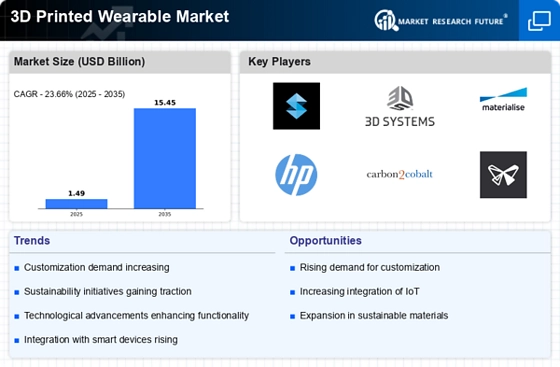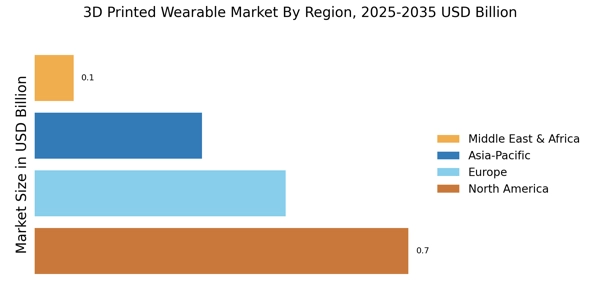Rise of Eco-Friendly Materials
Sustainability is becoming a pivotal concern in the 3D Printed Wearable Market, with a notable shift towards eco-friendly materials. Manufacturers are increasingly utilizing biodegradable and recyclable materials in their production processes, aligning with consumer preferences for sustainable products. This trend is reflected in market data, which suggests that the eco-friendly materials segment is expected to grow significantly, potentially reaching USD 10 billion by 2027. The adoption of sustainable practices not only enhances brand reputation but also attracts environmentally conscious consumers, thereby expanding the market reach of 3D printed wearables.
Integration of Smart Technology
The integration of smart technology into wearables is a key driver in the 3D Printed Wearable Market. As consumers increasingly seek multifunctional devices, the demand for wearables that incorporate smart features such as connectivity, data analytics, and interactive capabilities is on the rise. This trend is supported by market forecasts indicating that the smart wearable segment is expected to grow at a CAGR of 20% through 2025. The ability to combine 3D printing with smart technology not only enhances the functionality of wearables but also opens new avenues for innovation, positioning the industry for sustained growth.
Advancements in 3D Printing Technology
The 3D Printed Wearable Market is experiencing rapid advancements in printing technologies, which enhance the quality and efficiency of production. Innovations such as multi-material printing and improved resolution allow for the creation of intricate designs that were previously unattainable. This technological evolution not only reduces production costs but also shortens lead times, making it feasible for companies to respond swiftly to market demands. As a result, the industry is projected to grow at a compound annual growth rate of approximately 25% over the next five years. These advancements enable manufacturers to produce wearables that are not only functional but also aesthetically appealing, thereby attracting a broader consumer base.
Customization and Personalization Trends
The 3D Printed Wearable Market is witnessing a pronounced trend towards customization and personalization. Consumers are increasingly seeking products that reflect their individual styles and preferences. 3D printing technology facilitates this demand by allowing for tailored designs that cater to specific user requirements. Market analysis indicates that personalized wearables are projected to account for a substantial portion of the market share, with estimates suggesting a growth rate of 30% in this segment over the next few years. This trend not only enhances consumer satisfaction but also fosters brand loyalty, as customers are more likely to engage with brands that offer unique, customized solutions.
Growing Demand for Health Monitoring Devices
The increasing awareness of health and wellness is driving the demand for health monitoring devices within the 3D Printed Wearable Market. Consumers are increasingly seeking wearables that can track vital signs, physical activity, and other health metrics. This trend is supported by data indicating that the wearable health technology market is expected to reach USD 60 billion by 2026. The integration of 3D printing technology allows for the customization of these devices, ensuring they meet individual user needs. As health-conscious consumers prioritize personalized solutions, the 3D Printed Wearable Market is likely to see a surge in innovative health-focused products.


















Leave a Comment